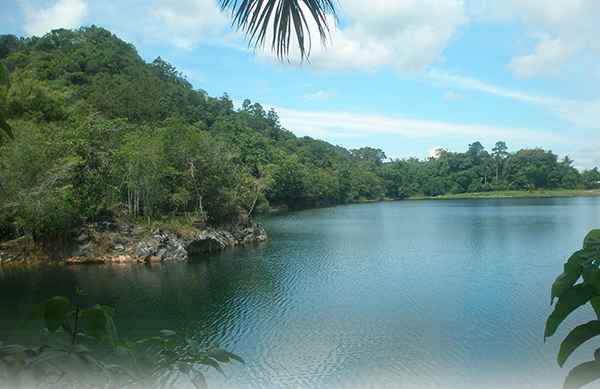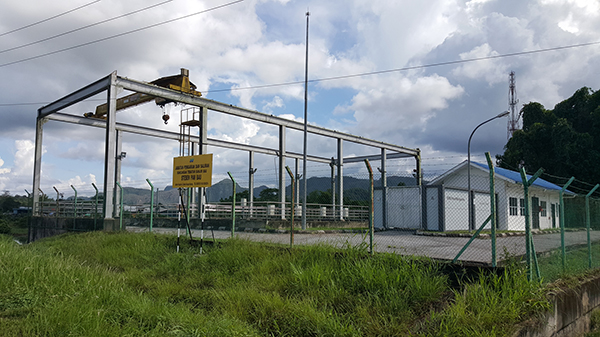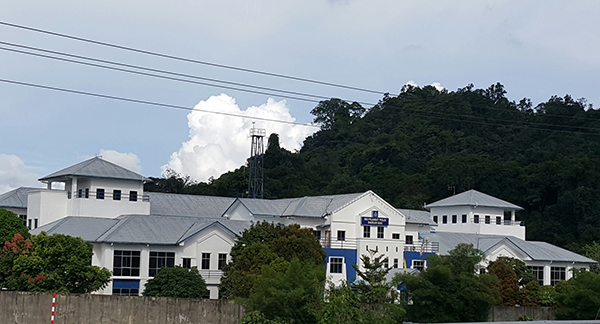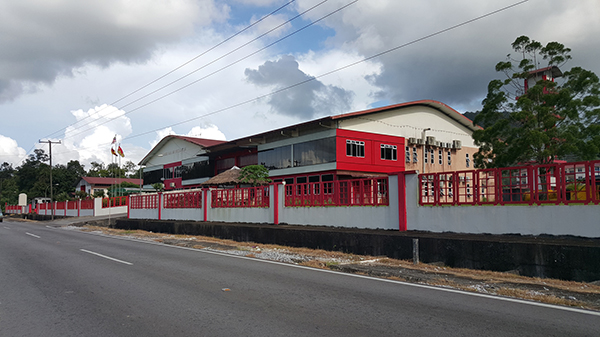
The greenish blue water of Tasik Biru.
ITS water appears greenish blue — possibly due to a mixed reflection of the green surroundings and the blue sky.
No, it’s not a natural lake but an artificial one, about 300 feet deep, that used to be an open cast gold mining pit operated by the Borneo Company from 1898 until it was flooded in 1921.
Located less than 1km from Bau bazaar, this man-made body of water was known as Tai Parit but later renamed Tasik Biru or Blue Lake.
The facilities around the lake are much better now. There are a few food and drinks stalls, a pontoon gangway, a viewing platform, public toilets, playgrounds, footpaths, lakeside railings, a car park and landscaping.
That, in a nutshell, depicts the present-day Tasik Biru, also known to many simply as Bau Lake.
Tasik Biru is also the name of a state constituency. It has grown by leaps and bounds over the past 20 years. And what we see in the vicinity of the lake is a just a small portion of the pie that has been divided among the areas within the constituency.
A lot of efforts have been made to transform this bucolic constituency. Even as urban development continues to expand at a steady pace, the rural areas are never forgotten.
A tour around Bau town as well as Jagoi, Singai and Bratak revealed some of the areas within these population centres have grown from backwater villages into flourishing well-equipped townships, well-poised to venture into another phase of rural development.
Tasik Biru constituency, covering about two-thirds of Bau District has, indeed, seen tremendous development and progress.
Almost all the people, including the community leaders, I talked to in Bau said the constituents are quite fortunate to have a leader like Tasik Biru assemblyman Datuk Peter Nansian Ngusie.
Even the farthest village within the constituency — Kampung Stass, which is very close to the Malaysian-Indonesian border — is now accessible by tar-sealed road, said village headman Jaoi Edward Ginip.
He said Nansian helped this kampung in many ways, pointing out that when the Tasik Biru YB first became the wakil rakyat 20 years ago, there was only a gravel road, constructed by the British army during the Confrontation in the 1960s, leading to their village.
The road back then, he noted, was not only winding and narrow but also muddy during the Landas and very dusty during the dry season.
“At the time, there were no treated water and electricity supply, let alone a telecoms tower at our village. But now, we have a good tar-sealed road, 24-hour electricity, clean treated water and a telecoms tower for Internet use. YB Nansian got all this for us.”

The Bau flood mitigation project.
Indelible mark
In terms of development, Jaoi said Nansian had left an indelible mark in Kampung Stass with the implementation of the 21st Century Desa Lestari Project which has given the villagers a co-operative, a mini stadium, a futsal court, a community hall, and a local fruit paradise as a heritage.
Jaoi pointed out that not a single community had been left out, noting the less populated Malay areas had also been brought into the mainstream of development.
A Malay penghulu for Bau-Buso area, Wahab Mainol, concurred, saying although the Malays constituted less than 10 per cent of the total population of Bau and Buso, the present wakil rakyat (Nansian) had given the community the same attention as the other major communities — the Bidayuhs and Chinese — in Bau District.
“He never fails to support us in our social and religious activities in terms of grants and personal attendance,” the penghulu revealed.
According to him, since Buso is subject to flooding, Nansian has provided the villagers with longboats and engines to carry out rescue operations in the event of a deluge.
“The flood evacuation centre in Buso was built with the YB’s help,” he said.
Leader for all
The Chinese community penghulu in urban Bau, John Luk, expressed satisfaction with Nansian’s leadership, pointing out that he is “a leader for all, not just the Bidayuhs”.
“As YB, he has been very supportive of the Chinese community, having helped us build our new Chung Hua School and also been instrumental in getting yearly government grants for the other Chinese schools in Bau District, especially in Tasik Biru.
“He regularly gives grants to our temple association and the Chinese associations in the area and celebrates our annual festivals with us,” he noted.
Describing Nansian as friendly and approachable, Luk said the YB had, through the state BN government, done a lot to make Bau what it is today.
He added that Nansian, who accepted a last-minute call from former Chief Minister and State BN chairman, Tun Pehin Sri Abdul Taib Mahmud, to contest in Tasik Biru in the 1996 state election, had a clear vision and mission for his constituency.
Luk believed Nansian, through the state BN, had been able to bring development and progress to the rural areas to not only help bridge the rural-urban socioeconomic gap but also contribute positively to the overall development of Sarawak and nation-building.
“He’s a person who analyses and strategises to achieve his vision and mission for his constituency.”

The new Bau police station.
Low-cost housing projects
Most people familiar with Bau town would agree it has quite a small population — with a small fire station, not enough schools and always subject to flooding.
Luk said as chairman of the Housing Commission in the late 1990’s, Nansian brought a low-cost housing project to Jalan Jambusan in Bau.
“He is the first leader to do this, eventually paving the way for housing development to sprout around Bau, making Bau town more vibrant today.”
Luk said the success of the low-cost housing project also prompted the government to build a school — SK Bau — and a big fire station which has become the Bomba Academy for the whole of Sarawak.
Due to the town’s growing population, a new bigger police station was built, and subsequently, the ground-breaking RM33 million-flood mitigation project to protect Bau town and the Bau police station from perennial flooding.
thesundaypost also had the opportunity to meet the Bidayuh community pemanca in Bau District, Daniel Teho J Regaw, to talk about the development in Tasik Biru.
He too believed the present assemblyman was behind the transformation of Bau District.
Having known the incumbent for 36 years — 16 years as a colleague in the Bintulu Development Authority — he said Nansian had looked at three main aspects of human development in the constituency — physical, spiritual and mental.
“He has the knowledge, experience and burning desire to do this. I think he has served his area well as the YB.”
Daniel recalled 20 years ago, basic infrastructure like roads, water and electricity supply were greatly lacking in most of the villages.
But following Nansian’s persistent requests and follow-ups with the government of the day, almost all the villages in the Tasik Biru constituency have been linked with tar-sealed roads and enjoy treated water and 24-hour electricity.
Moral and spiritual realms
Daniel said Nansian is also committed to helping his constituents understand the necessity for growth and maturity in the moral and spiritual realms of life.
He added that to help them become men of character who would uphold the values of honour, courage and commitment,
Nansian had, over the past 20 years, been regularly giving out government grants to all the religious groups in the area for their activities and for building their churches, temples and mosques or suraus.
“I was told in 2015 alone, he managed to get a special government grant, amounting to RM1 million, for the churches and other houses of worship in Tasik Biru.”
Daniel disclosed that being a religious person, Nansian had, through the Association of Research and Development Movement of Singai (Redeems), kept the Praise Music Festival going over the past six years to enhance the spiritual values of the youths and forge unity and fellowship among mankind.
He said Nansian had also been sharing his views on religion and conveying the liberal stand of the state government under the new Chief Minister so that Sarawakians could continue to live peacefully and harmoniously despite coming from different religious and racial backgrounds.
“Although he’s a Christian, he always respects other religions. He always says people are free to follow whatever religion they embrace but they must never look down on other people’s religions.
“Every effort he made for the people’s spiritual growth, he did it to facilitate the involvement of each community in the activities of their faith,” Daniel said.

The Bomba Academy in Taiton, Bau.
